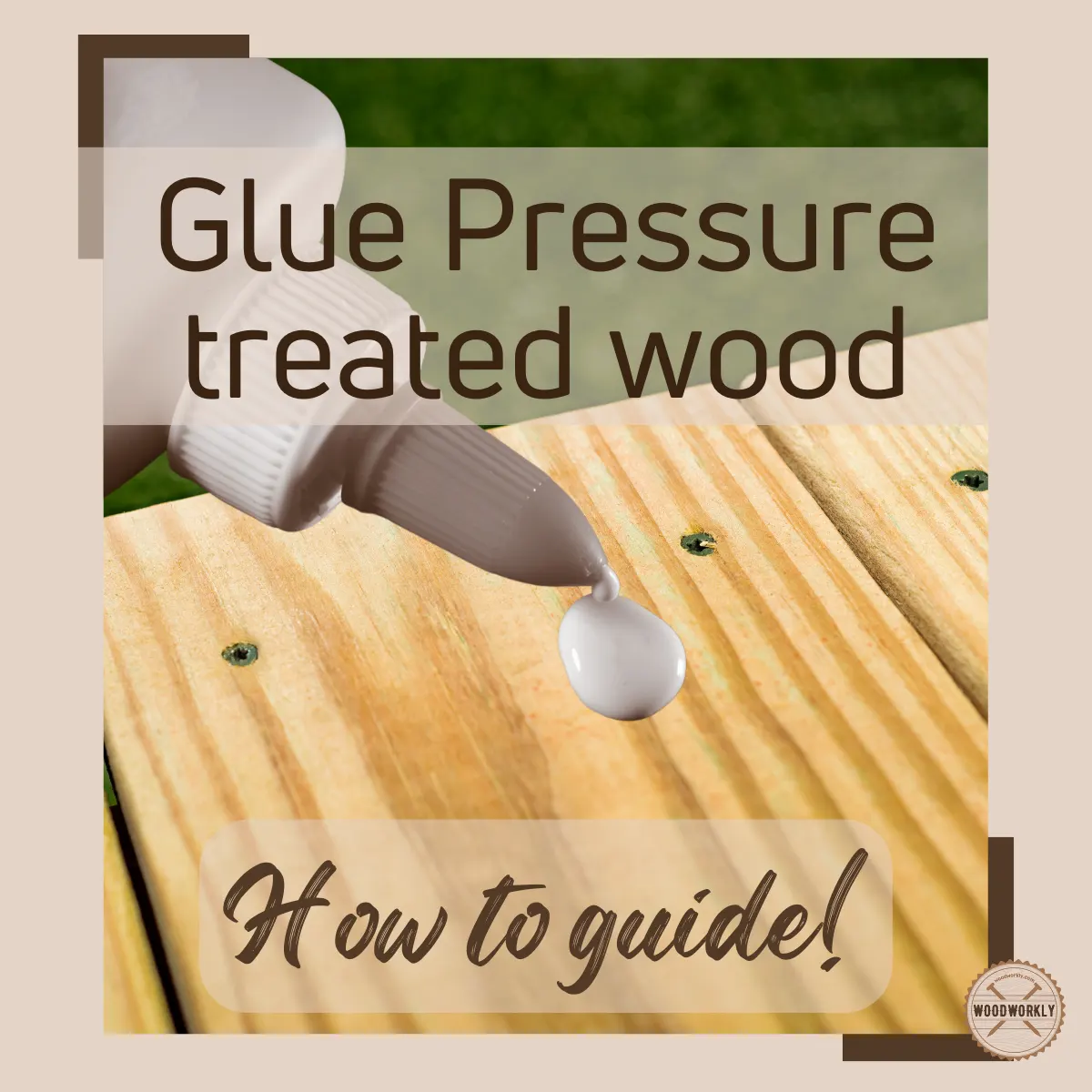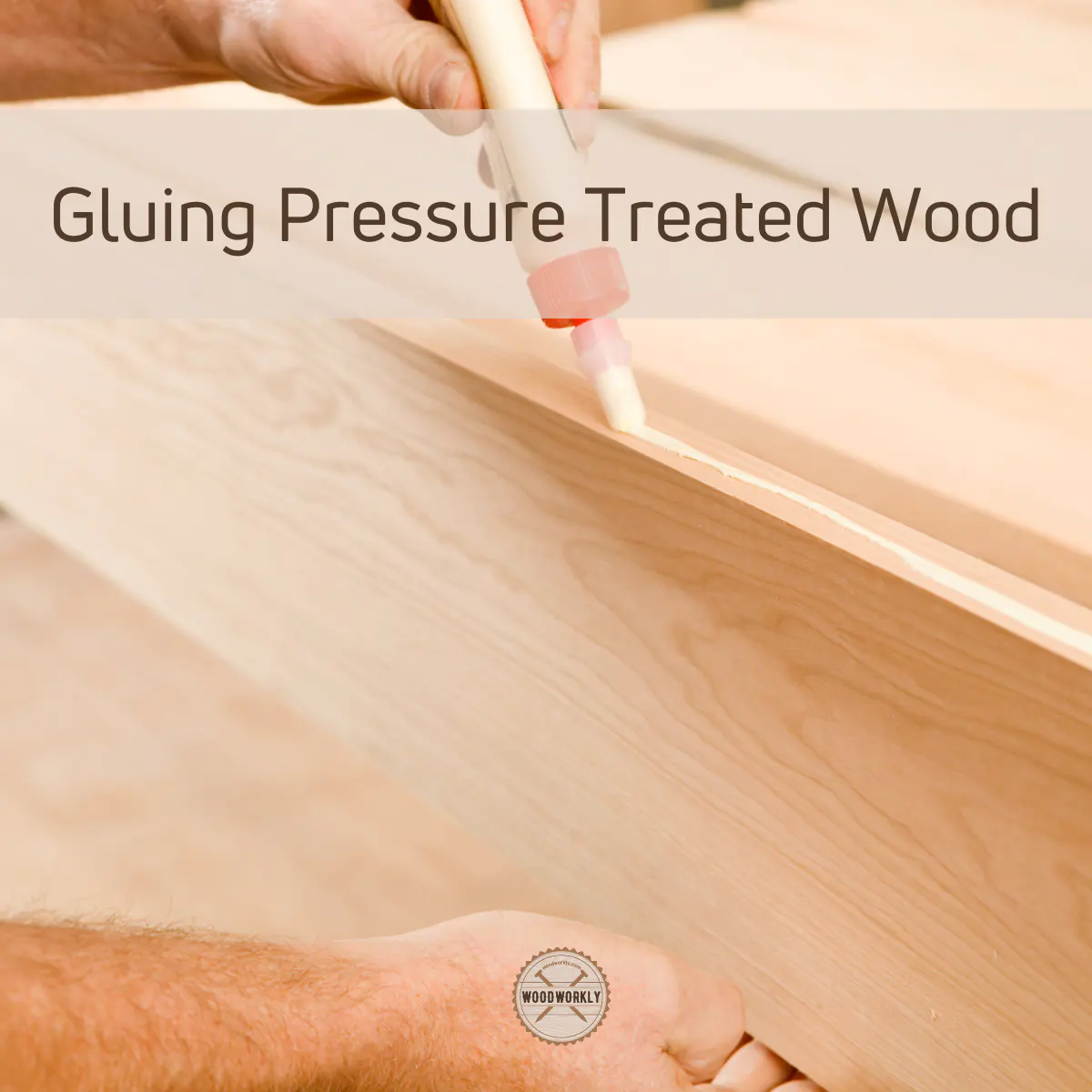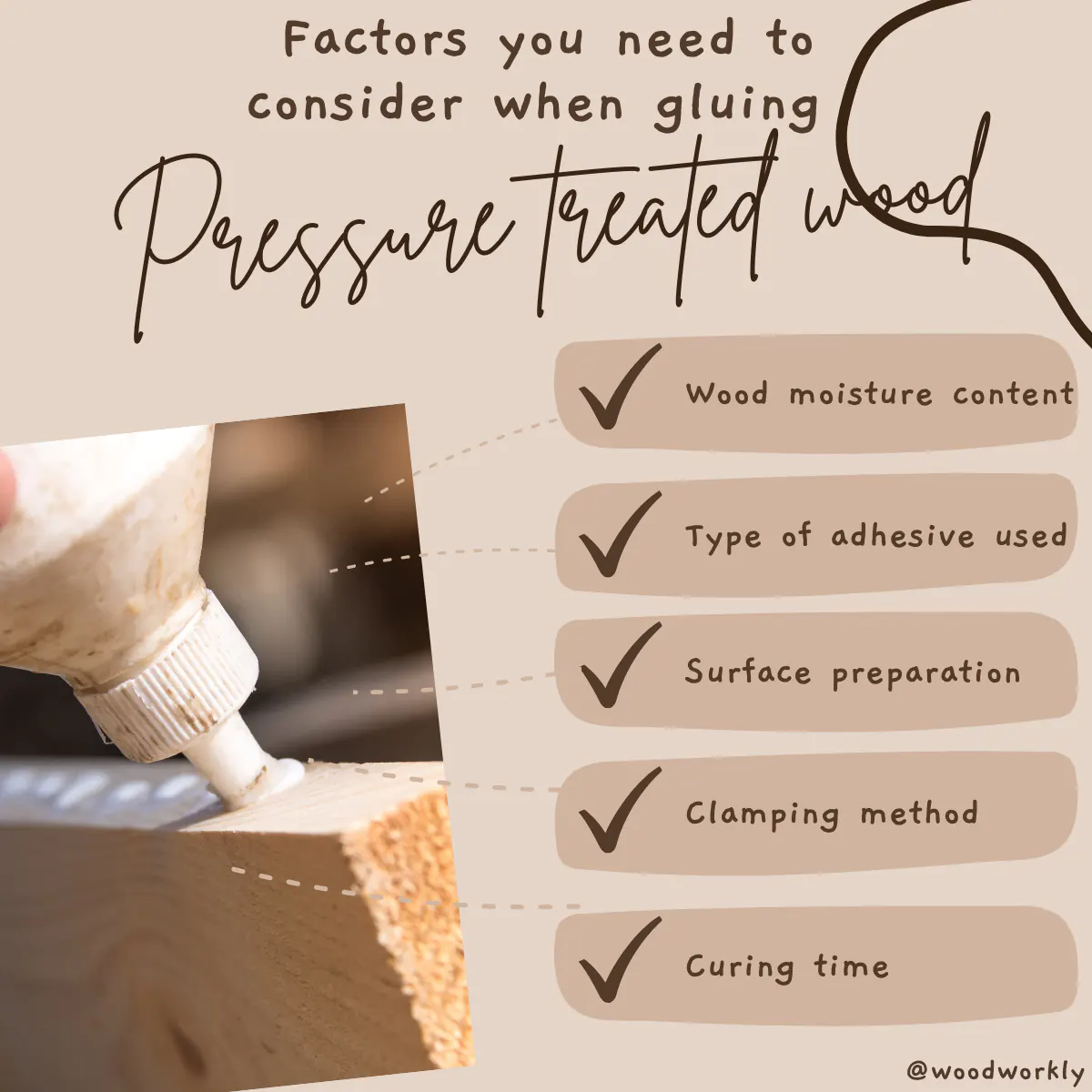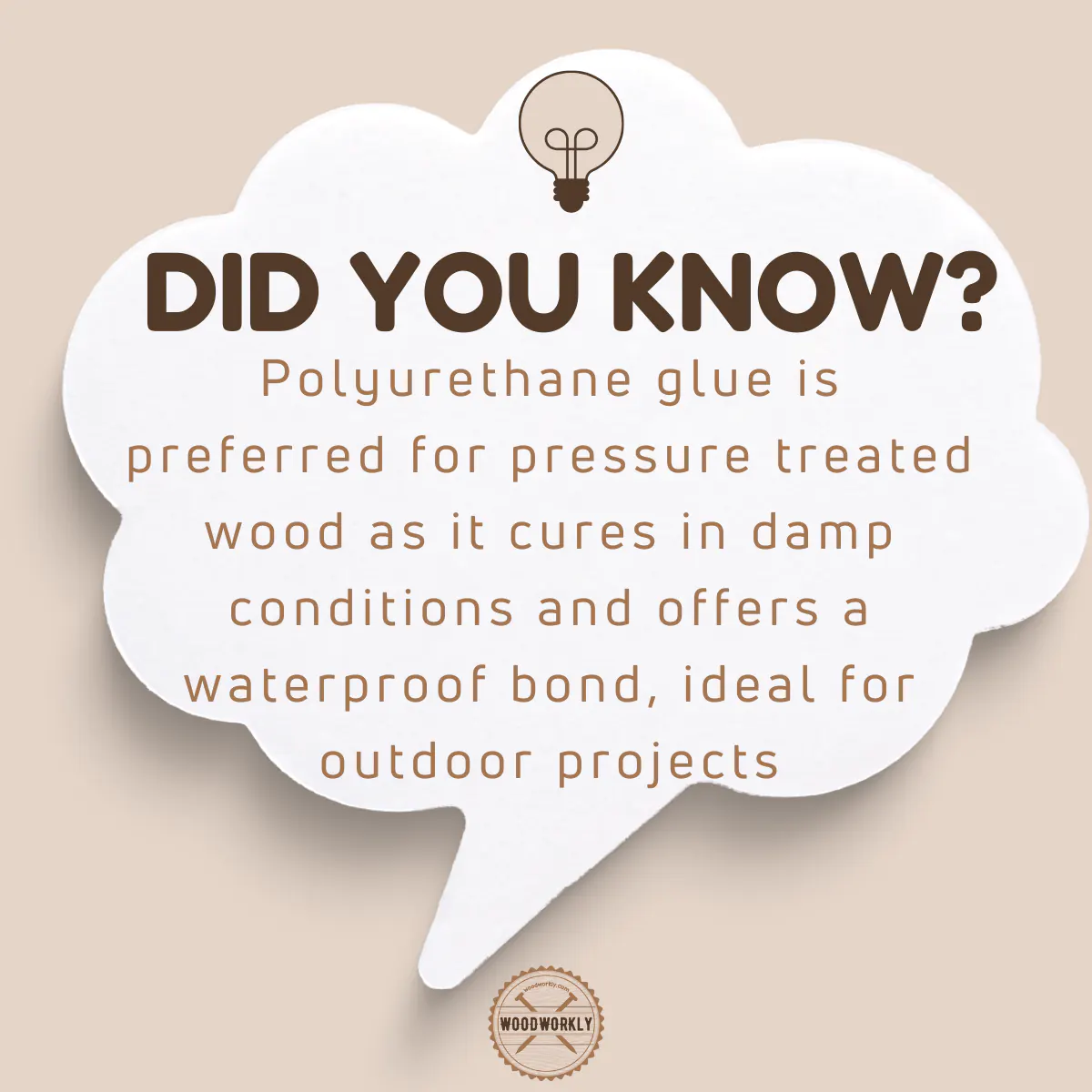Ever struggled with bonding pressure treated wood? Discover foolproof methods to achieve a strong, durable bond that withstands the elements. Curious? Read on!

The success of gluing pressure-treated wood depends on using the right type of glue and following proper procedures.
Because pressure-treated wood is commonly used for outdoor projects due to its resistance to insects and decay, care must be taken when gluing pressure-treated wood.
If you have come to know about it, you have come to the right place. Because I aslo had the same question long time ago and able to find the answer thanks to the experts.
Now with years of experience, I’ve glued different types of pressure treasted wood for various projects.
So, here is How to glue pressure treated wood?
To glue pressure-treated wood, choose a polyurethane-based adhesive suitable for outdoor use. Clean and prepare the surfaces, perform a compatibility test, apply the adhesive evenly, use clamps for stability, and allow ample curing time for a robust bond.
Now don’t think that you are fully aware of this, there are actually many other things that you should be aware of.

I’ll walk you through the ins and outs of gluing pressure-treated wood in this detailed guide.
I’ll also explore the best glues for pressure-treated wood, considerations before buying resin glue, and essential supplies for a successful gluing project.
Additionally, we address common queries such as whether epoxy can adhere to pressure-treated wood and the suitability of screws in such applications.
So let’s get started!

Can You Glue Pressure Treated Wood?
Certainly! Yes, you can glue pressure-treated wood, but using the right type of glue is essential.
For outdoor use, pressure-treated wood is used, which is treated with chemicals to resist insect damage and decay.
Because these chemicals can affect the adhesive bond, I recommend you use a construction adhesive specifically designed for outdoor or treated wood.
Remember to always choose construction adhesives labeled for use with high-quality polyurethane-based adhesives or pressure-treated wood.
Also, follow the manufacturer’s instructions carefully and ensure that the surface is clean and dry before applying the adhesive.
Additionally, consider using mechanical fasteners, such as screws or nails, in conjunction with adhesives for a strong and reliable bond, especially in load-bearing applications.

What Glue Works Best For Pressure-Treated Wood
When choosing glue for pressure-treated wood, do not forget to consider the special characteristics of the material and exposure conditions.
Among the various options available to you in the market, resorcinol resin glues are known as the choice to achieve a waterproof adhesive line ensuring durability in outdoor applications.
Now let’s look at what glue works best for pressure-treated wood in detail.
Polyurethane Glue
Did you know that polyurethane glue was created as a stellar alternative for pressure-treated wood projects?
A unique feature is its water resistance, this glue works well even when the wood is slightly damp.
Its ability to handle porous end grain is especially valuable for effectively joining pressure-treated wood.
Popular brands like Gorilla Glue are widely used in this context, providing reliable results.
Check out, How to Remove Gorilla Glue from Wood? (EASY Guide!)
Polyvinyl and Urea Resin Glues
Did you know that polyvinyl and urea resin glue provides a waterproof bond?
Although this glue is suitable for certain applications, it may not provide the level of protection needed for pressure-treated wood exposed to the elements.
In addition, these glues show good moisture resistance, they withstand the high humidity of wood, and they work effectively at lower temperatures compared to conventional glues.
Yellow Glue (Polyvinyl Acetate)
Yellow glue is especially popular among carpenters, belongs to the polyvinyl acetate family.
It is ideal for cabinet and furniture construction, providing strong bonds that exceed the strength of wood once cured.
Yellow glue can clean wet and sandy water well, but it is not the best choice for wet materials.
Titebond III
Titebond III is good sanding water-resistant glue that offers an open time of approximately ten minutes.
It is water resistant when dry, and can be cleaned easily when wet.
This glue is an excellent choice for outdoor furniture, cutting boards or any project where moisture is a consideration.
Cyanoacrylate (CA)
Did you know that cyanoacrylates, available in different viscosities, offer faster bonding capabilities?
The thin variety is suitable for reinforcing punky wood, the thick version effectively fills gaps.
However, CA is brittle glue and is not suitable for applications where daily use may cause cracking.
The choice of glue depends on the specific demands of the project and don’t forget that open time, water resistance, sanding ability and the nature of the wood are critical factors in making an informed decision for pressure-treated wood applications.

Factors Should You Consider Before Purchasing a Resin Adhesive for Pressure Treated Wood?
Pressure-treated wood, commonly used for exterior and ground contact applications, requires strong adhesives with polyurethane (PU)-based components for optimal performance.
By considering the following factors, you will be able to choose a resin adhesive for pressure-treated wood that will ensure a successful and durable bond.
1. Nozzle Tip Design
Always choose a resin adhesive with a well designed nozzle tip.
This feature facilitates precise application and allows you to control the amount of glue released.
Nozzle tips are especially beneficial when working on complex projects or in tight spaces, helping to prevent waste and ensure a neat application without making a mess.
2. Versatility and Adhesion on Textured Surfaces
Always choose a resin adhesive that has the versatility to effectively adhere to surfaces with different textures.
Pressure-treated wood is often irregular and rough-textured, so on such substrates you need an adhesive with excellent bonding capabilities.
That way, you will be able to ensure a reliable and durable connection between the wooden components.
3. Heat and Water Resistance
Do not forget to evaluate the heat and water resistance of the resin adhesive before making a purchase.
Since pressure-treated wood is often used in outdoor settings, exposure to various weather conditions is inevitable.
Ensuring that the adhesive selected is resistant to both heat and moisture will provide you with a bond that will last and resist over time.
This feature is very important to maintain the integrity of the adhesive joint in various environmental conditions.
4. Curing Time
Consider the curing time of the glue. Different adhesives have different drying times, from as little as 30 minutes to a full day.
The choice depends on the nature of your project and your workflow preferences.
While quick-cure adhesives may be more appropriate for projects that require quick completion, longer cure times are acceptable for projects with longer assembly periods.
By considering these factors and exploring reliable adhesive options, you can make an informed decision to ensure the success of your pressure-treated wood projects.

Best Adhesive to Glue Pressure Treated Wood
For your convenience, I have tabulated a table of the types of glue you can find in the market and their details.
| Glue | Key Features | Where to Buy |
|---|---|---|
| Titebond III Ultimate Wood Glue, Quart | Water-resistant, Good sanding ability, Approximately 10 minutes of open time | Hardware stores (e.g., Home Depot, Lowe’s), Online retailers (e.g., Amazon) |
| Titebond Cross-Linking Polyvinyl Acetate Wood Glue | Versatile adhesive for various applications, Excellent bonding on textured surfaces, Nozzle tip for precise application | Hardware stores, Online platforms |
| Titebond Original Wood Glue, Yellow | Yellow glue is ideal for woodworking projects, Water-cleanable while wet, Stronger than wood once cured | Local hardware stores, Home improvement retailers |
| Gorilla Original Waterproof Polyurethane Glue | Waterproof polyurethane adhesive, Suitable for pressure-treated lumber, Ideal for damp wood applications | Major retail stores, Online marketplaces |
| Gorilla Wood Glue for Pressure-Treated Lumber | Specifically formulated for pressure-treated wood, Bonds well in damp conditions, Polyurethane-based for water resistance | Home improvement stores, Available online |
| C-TOUGH Epoxy Adhesive C-TOUGH by CECCORP | Epoxy adhesive for demanding applications, High strength and durability, Suitable for pressure-treated wood | Specialty adhesive retailers, Industrial supply stores |
| Roberts Indoor/Outdoor Carpet Glue for Pressure-Treated Plywood | Adhesive for carpet on pressure-treated plywood, Indoor/outdoor use | Flooring supply stores, Specialty retailers and online platforms |
Read to know, Can You Use Pressure Treated Wood Indoors: Uses & Dangers!

Supplies You Will Need to Glue Pressure Treated Wood
Successfully gluing pressure-treated wood requires the right tools and materials to ensure a strong and durable bond.
Below I have created a list of the essential supplies you will need for the process.
- Polyurethane-based adhesive
- Brush or spatula
- Clamp
- Wet cloth or sponge
- Safety gear
- Wood sealer or finish (optional)
- Sandpaper or cutting tools
- Pressure-treated wood chips
- Gloves
- Mechanical fasteners (optional)
By gathering these supplies, you’ll be well prepared to tackle your pressure-treated wood gluing project efficiently and effectively.
Remember to always follow the manufacturer’s instructions for adhesives and safety equipment to get the best results.
How to Glue Pressure-Treated Wood
Bonding pressure-treated wood requires careful consideration and adherence to specific steps to ensure a strong and durable bond.
Here are the steps you need to follow when gluing pressure-treated wood,
- Surface preparation
- Choosing the right glue
- Perform the test match
- Apply the adhesive
- Make stable connections along the glued area
- Clean off excess glue
- Drying and curing
- Post-healing
Let us now talk about each of the above steps in detail.
1. Surface Preparation
Before applying any glue, it is imperative to ensure that the surface to be glued is clean, dry and free of dirt, debris or contaminants.
I suggest you use a brush or compressed air to remove sawdust or loose particles from the wood.
2. Choosing the Right Glue
Choosing the right high-quality glue for pressure-treated wood is an important step.
I recommend that polyurethane-based adhesives are suitable for water-resistant properties, which are often essential for outdoor applications.
3. Perform the Test Match
Do a small consistency test by applying a small amount of the chosen adhesive to a piece of pressure-treated wood.
That way you can make sure that the glue bonds well with the specific chemicals and characteristics of the pressure-treated wood.

4. Apply the Adhesive
Here you apply glue evenly on one surface to be glued. If necessary, you can use a brush or spatula to spread the glue here.
Avoid over-applying to avoid loosening the joints and weakening the bond.
5. Make Stable Connections along the Glued Area
In this step, press the two surfaces firmly together, making sure there is a stable connection along the entire glued area.
If necessary you can apply clamps to hold the pieces together here.
For larger projects, remember to use mechanical fasteners in addition to glue for extra strength.
6. Clean Off Excess Glue
At this step, you can immediately wipe off excess glue using a damp cloth or sponge.
Polyurethane adhesives can expand as they cure, so remember that it’s important to remove excess adhesive before drying to maintain a neat and professional appearance.
7. Drying and Curing
Allow the glued assembly to dry and cure according to the adhesive manufacturer’s instructions.
Drying and Curing time can vary depending on the type of glue used, from a few hours to a full day. Avoid disturbing the glued joint during this period.
8. Post-Healing
After the glue has completely cured, test the glued joint for strength and integrity.
Make sure the bond is strong and there are no signs of separation or weakness. If necessary, sand or cut off excess glue.
Read to know, Can You Sand Pressure Treated Wood? (Ultimate Guide!)
By following these steps, you can achieve a secure and durable bond when gluing pressure treated wood, ensuring the success and durability of your woodworking projects.

Tips for Gluing Pressure Treated Wood
Here are some tips for gluing pressure-treated wood that I’ve used for a long time to get promising results.
- Always ensure that the surfaces to be glued are clean, dry and free of any contaminants.
- Always choose a high-quality polyurethane-based adhesive known for its water-resistant properties.
- Before applying adhesive to your project, conduct a small consistency test on a piece of pressure-treated wood.
- Use a brush or spatula to apply the adhesive evenly on the surfaces to be bonded.
- When joining the surface, use clamps to ensure even pressure along the glued area.
- Polyurethane adhesives can expand as they cure, so it’s important to wipe off excess adhesive immediately using a damp cloth or sponge.
- For added strength, especially in load-bearing applications, consider using mechanical fasteners such as screws or nails in combination with glue.
- Wear appropriate protective gear, including gloves and safety glasses, to protect yourself from possible skin irritation or fumes from the glue.
- Always follow the manufacturer’s instructions regarding curing time.
- If the project involves outdoor exposure, consider applying a wood sealer or finish to protect the adhesive joint from moisture and environmental elements.
- After the glue has fully cured, test the joint for strength and integrity. Make sure there are no signs of separation or weakness.
By following these tips, you can improve the efficiency of gluing pressure-treated wood and ensure the durability and longevity of your woodworking projects.
Will Epoxy Stick to Pressure Treated Wood?
Yes, epoxy can stick to pressure-treated wood, but the success of the bond depends on proper surface preparation and choosing the right type of epoxy.
Pressure-treated wood is often treated with chemicals that affect adhesion.
Here are the steps you need to follow when using epoxy to pressure treated wood,
- Surface Preparation
- Choose the Right Epoxy
- Follow the Manufacturer’s Instructions
Now let’s look at this step in detail.
1. Surface Preparation
Always ensure the pressure-treated wood surface is clean, dry and free of contaminants.
Lightly sanding the wood can improve the surface for better adhesion.
2. Choose the Right Epoxy
Always choose an epoxy adhesive designed to bond well with treated wood.
Some epoxy formulations are specially formulated for challenging surfaces such as pressure treated wood.
3. Follow the Manufacturer’s Instructions
Carefully follow the manufacturer’s instructions for the selected epoxy, including recommended application conditions, curing times, and any specific surface preparation steps.
By following these guidelines, you can achieve a strong and reliable bond between epoxy and pressure treated wood for a variety of woodworking and construction projects.

Can I Use Screws in Pressure Treated Wood?
Yes, you can use screws in pressure-treated wood.
In fact, using screws is a common and effective way to fasten wood under pressure in construction and woodworking projects.
However, it is important to choose screws that are specifically designed to use treated wood to ensure durability and resistance to corrosion.
Stainless steel or hot-dip galvanized screws, which can be accelerated by the chemicals used in the wood treatment process, are recommended for pressure-treated wood as they are less susceptible to rust and corrosion.
Always follow the guidelines provided by the screw manufacturer and consider the specific application requirements to achieve a secure and long-lasting connection in pressure-sensitive wood projects.
Congrats folks! Now you know how to glue pressure treated wood properly without messing things up.
So, let’s answer some frequently asked questions.
FAQs
Can you use regular wood glue for pressure-treated wood?
No, regular wood glue is not recommended for pressure-treated wood because of the wood’s chemical treatments and moisture content. Specialized adhesives like polyurethane and yellow glue that can withstand damp conditions and adhere well to chemically treated surfaces are advised.
How long should you allow pressure-treated wood to dry before gluing?
Allow pressure-treated wood to air dry for about 24 hours before applying glue, especially if using adhesives other than polyurethane which can adhere well to damp surfaces and cures in the presence of moisture.
What types of glue are best for pressure-treated wood?
Polyurethane glue is highly recommended because it’s water-resistant and works well on damp surfaces. Other options include Titebond III and yellow glue, provided the treated wood is dry before application.
Is it necessary to clamp glued pressure-treated wood pieces while drying?
Yes, clamping is essential to hold the glued pieces together while the adhesive cures, ensuring a strong, durable bond.
Can you glue pressure-treated wood to concrete?
Yes, pressure-treated wood can be glued to concrete using construction adhesives and sealants, with specific application techniques varying depending on the type of adhesive used.
Is Gorilla Glue suitable for pressure-treated wood?
Yes, Gorilla Glue, particularly the polyurethane formula, is waterproof, super strong, and suitable for bonding pressure-treated wood, making it ideal for outdoor projects.
How do you prepare the surface of pressure-treated wood for gluing?
The surface should be cleaned with a mixture of mild dish soap and water and allowed to dry. If necessary, lightly sand the surface to even it out, taking care not to oversand and strip away the protective chemical layer.
Is it possible to speed up the drying process of the glue on pressure-treated wood?
The curing time largely depends on the type of glue used; typically, it’s advised to let the bond dry for 8 to 24 hours for maximum strength, and rushing this process is not recommended for optimal results.
What safety precautions should be taken when working with pressure-treated wood?
Wearing a dust mask or respirator and heavy-duty gloves is advised to protect against the chemicals in the treated wood, especially during sanding or planing processes.
Do you need to nail or screw the glued pressure-treated wood pieces?
No, nailing or screwing is not required if the pieces are clamped well and allowed to cure properly; the adhesive bond should be strong enough to hold the pieces together securely.
Did I cover all you wanted to know about: How to Glue Pressure Treated Wood
In this article, I’ve deeply discussed, how to glue pressure treated wood correctly using the right techniques with expert tips.
You can glue pressure treated wood by first, cleaning and drying the pressure-treated wood. Then, apply specialized glue like polyurethane or yellow glue evenly on the surface. Press the wood pieces together and clamp them to secure the bond. Allow to cure for at least 24 hours for maximum bond strength. Ensure the wood is dry if not using polyurethane glue.
Furthermore, I’ve answered some frequently asked questions as well.
Hope you’ve learned all you wanted to know about how to glue pressure treated wood using the right way using the right adhesives.
Now it’s your time to take a scrap pressure treated wood and practice so well before entering to the main project. Practice is what makes you perfect in woodworking!
Related Posts
- How To Get Green Off Pressure Treated Wood (EASY Methods)
- Does Wood Glue Work on Painted Wood? Find Out Now!
- Does Wood Glue Work on MDF? [EASY Guide to Glue MDF]
- Does Wood Glue Work On Stained Wood? (EASY Guide!)
- How to Glue Plywood Together (EASY Guide!)
- Glue Wood Without Clamps (17 EASY Ways!)
- Can You Paint On MDF (EASY Guide!)